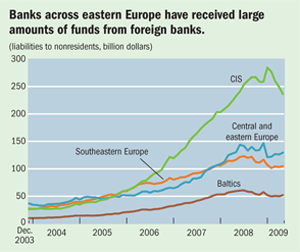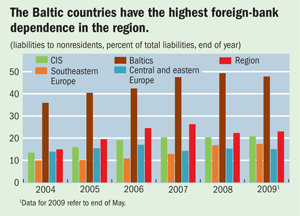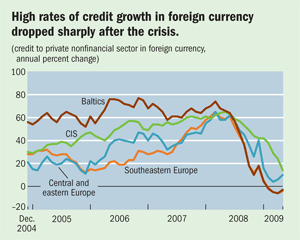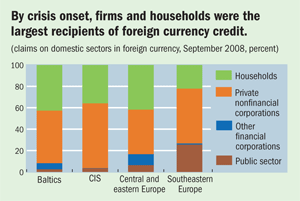Flows to Eastern Europe
Finance & Development, September 2009, Volume 46, Number 3
Foreign banks have supported eastern European banks, but the financial crisis has reversed this trend
 FOREIGN (mostly western European) banks dominate the eastern European banking system. Overall financing from foreign sources for countries in eastern Europe increased from about $96 billion in December 2003 to a peak of $550 billion in September 2008. All four subregions—the Baltics, central and eastern Europe, the Commonwealth of Independent States (CIS), and southeastern Europe— showed a significant increase in their dependence on foreign banks, led by a ninefold jump in five years in the foreign liabilities of the banking sector in the CIS to $280 billion. With the worsening of the global financial crisis in September 2008, this trend reversed for all groups.
FOREIGN (mostly western European) banks dominate the eastern European banking system. Overall financing from foreign sources for countries in eastern Europe increased from about $96 billion in December 2003 to a peak of $550 billion in September 2008. All four subregions—the Baltics, central and eastern Europe, the Commonwealth of Independent States (CIS), and southeastern Europe— showed a significant increase in their dependence on foreign banks, led by a ninefold jump in five years in the foreign liabilities of the banking sector in the CIS to $280 billion. With the worsening of the global financial crisis in September 2008, this trend reversed for all groups.
 Foreign liabilities rose, on average, as a ratio to total liabilities, from 12 percent to 19 percent for all countries. The highest foreign-bank dependence is found in the Baltic countries, with the ratio ranging from 33 percent in December 2003 to a peak of 50 percent in October 2008.
Foreign liabilities rose, on average, as a ratio to total liabilities, from 12 percent to 19 percent for all countries. The highest foreign-bank dependence is found in the Baltic countries, with the ratio ranging from 33 percent in December 2003 to a peak of 50 percent in October 2008.
 This increase in foreign financing was paralleled by extremely high rates of credit growth, in both national and foreign currency, to the private nonfinancial sector—mainly to nonfinancial corporations and households. However, the deterioration in the global financial environment since September 2008 brought about a rapid decline in the growth rate of credit, which actually has been negative since February 2009 for the Baltic and southeastern European countries.
This increase in foreign financing was paralleled by extremely high rates of credit growth, in both national and foreign currency, to the private nonfinancial sector—mainly to nonfinancial corporations and households. However, the deterioration in the global financial environment since September 2008 brought about a rapid decline in the growth rate of credit, which actually has been negative since February 2009 for the Baltic and southeastern European countries.

About the database
The data are derived from the standardized forms currently used by 114 countries to report monetary data to the Statistics Department of the IMF. Countries were arranged into four groups: CIS (Armenia, Azerbaijan, Belarus, Georgia, Moldova, Russia, and Ukraine); southeastern Europe (Albania; Croatia; Macedonia, FYR; Romania; Serbia; and Turkey); the Baltics (Estonia, Latvia, and Lithuania); and central and eastern Europe (Czech Republic, Hungary, Poland, and Slovak Republic). Most of the data used in this article can be accessed via International Financial Statistics Online at http://0-elibrary--data-imf-org.library.svsu.edu/DataExplorer.aspx
Prepared by José C. Moreno and Ricardo Davico of the IMF’s Statistics Department.


